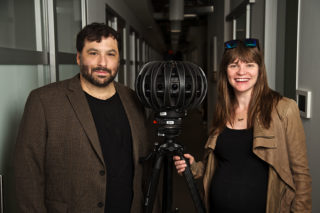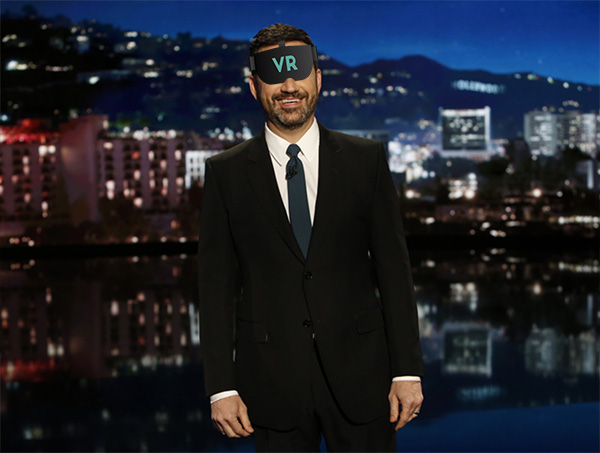Over one billion people around the globe will regularly access augmented and virtual reality content by 2020.
With an immersive experience storm predictably looming, a cavalcade of brands and creators are aligning allegiances to satisfy in what’s looking to be an insatiable appetite for VR content.
Earlier this year, Jimmy Kimmel was the latest to jump on the VR train by inviting fans to his desk in a near-two-minute, 360-degree experience that gave viewers an inside look at what it’s like to be a guest on his show.
Annie Lukowski and BJ Schwartz, co-heads of Vanishing Point Media, a Los Angeles-based VR content production company that produced the 360-degree project for Kimmel and has also done the same for Banana Republic, Stan Lee’s Comikaze, Jeep, Teen Vogue and USA Network, joined [a]listdaily to share why brands are increasingly diving deep into the immersive content format.
Why was the collaboration with Jimmy Kimmel a good fit for the Vanishing Point Media company profile? How was the partnership formed? What details can you share about how it was received from post-publishing till now?
BJ: Annie and I met at USC film school. We had a friend, and fellow student, who was a producer on Jimmy Kimmel Live, and when he found out what we were up to, he contacted us. We had a conversation with some writers and producers. At first we actually talked ourselves out of the gig. We tried to help them figure out what they wanted and how they could do it at a lower cost.
Annie: We thought they didn’t want to work in VR, but a month later they realized they wanted to do a VR production, and they again reached out to us. It was important for us to help them find the best fit, because the medium is still so new, we want everything with it to be a positive experience.
BJ: We really want to make sure that the content out there is good so that people catch onto the VR trend and get interested and excited for it. As a filmmaker, it’s most important that people engage and like your content.
Annie: It’s really rewarding when you see people interacting with your work, and in the end, that’s what we really hope to achieve as filmmakers, and we think we did achieve this with the Jimmy Kimmel Live experience.
When working with brands like Banana Republic on 360-degree content, what are you helping them accomplish? Why are they creating such videos in the first place?
Annie: Banana Republic is such a fantastic, well-respected brand, and I think it’s great that they wanted to try something new and experiment. They seemed to be curious about this new technology, so they just went for it. It’s a great way to interact with potential customers because they have to look all around, and receive a much higher level of engagement.
BJ: It was just a really fun way to introduce their summer line. There was this beautiful woman who you were accompanied by, and she would show you all of the different clothing in this beautiful city, Charleston, South Carolina. The viewer would be presented with a cool effect where she seamlessly switches dresses and scenery, allowing the viewer to intimately explore their brand.
Why is it imperative for brands to use 360-degree video and VR for their integrated marketing strategies?
Annie: Firstly, it’s fashionable.
BJ: You don’t want to ignore the hottest media out there.
Annie: People are underestimating how many people want this, and how important this interaction between the technology with the brand and the audience is.
BJ: People identify immediately after they interact with the VR ads.
Annie: When people are watching VR they aren’t paying their bills, or cooking dinner—they have a headset on, and all they are watching is your content. That’s great for filmmakers and advertisers. There are so many different ways to get the audience involved.
What have you learned along the way about creating engaging VR experiences?
Annie: As narrative filmmakers, we’re definitely very focused on what our audiences are looking for. We don’t come from a tech background, or advertising background—we think. First and foremost, what do people want to watch? How do we get them? And what do we need to do? Because if the content is not compelling, it doesn’t matter what medium you’re using. So we are able to know what the audience is looking for, how they will engage with it and what we need to do to get to that level, is easy to achieve through our knowledge from being narrative filmmakers.
BJ: I think just really stressing that you can’t replace experience. We’ve had a lot of experience learning about what affects people and what people enjoy watching just by being around people and giving them material. And so after seeing students who are new to VR, and people who are new to this material, who want to be more engaged with it, work with it, you can see that the years of experience are just so important in making the content the best it can be.

What needs to happen in 2017 for the industry to take the next step?
Annie: Distribution. We don’t always have that much narrative content. People watch this material because of the dripping, jaw-dropping content.
BJ: They have to know what happened. The medium will affect what it is, but we want them to be talking about the content and the ‘I don’t know what’s going to happen next but I have to find out.’
How would you describe the current consumer appetite for VR content? What kind of an experience works best for the platform?
BJ: The appetite is definitely large and growing.
Annie: And hungry. But the hardest stumbling block is definitely the distribution. The headsets, the technology, the app store.
BJ: Yeah there’s no appetite for dealing with that. Once we get through that hurdle, then it will be a much clearer answer to what people are looking for.
Annie: As for the platform, we’re big supporters of first person and third person—interactive and non-interactive work.
BJ: As a general matter, people come wanting experience, as in an adventure. But they leave being most struck by intimate moments. You take people to a place they’ve never been, or a place they’re dying to go. There is nothing more powerful in VR experience than someone making eye contact with the viewer. There are a wide range of things that work, but there are some things that are particularly amazing.
Follow Manouk Akopyan on Twitter @Manouk_Akopyan

